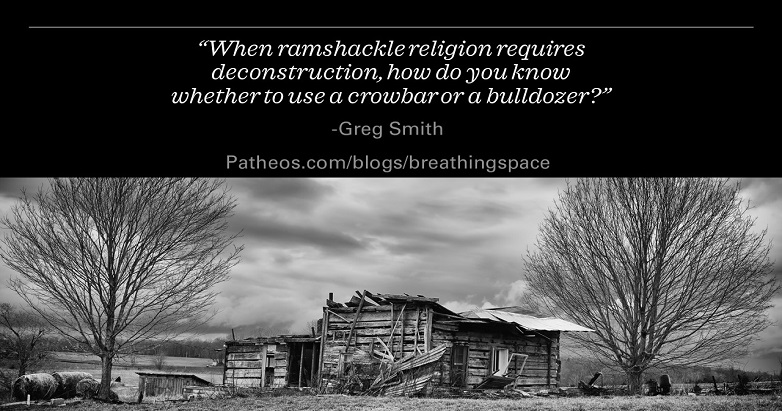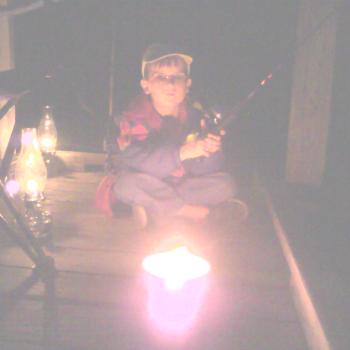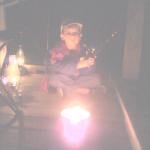Some old houses can be remodeled, and some need to be torn down. Is your religion a fixer-upper, or a demolition zone?

Once I rented a hundred-year-old farmhouse that the property owner was renovating around us. At the same time, our closest neighbor took his turn-of-the-twentieth-century home down to the studs to rebuild it. His ended up looking great, and ours—not so much. The difference between these two properties? His was built on a good foundation, while ours was constructed on broken stone pillars. His home needed serious remodeling, while ours should have been condemned.
Ramshackle Religion
When ramshackle religion requires deconstruction, how do you know whether to use a crowbar or a bulldozer? Whether to deconstruct or demolish? Ask yourself two questions:
- What’s the foundation like? A house built on a poor foundation is best taken down entirely. The same is true with poorly built religion. If you’re a Christian because your grandma was, or because church is a good place to make social or political contacts, that may not be an adequate foundation to support the rest of your house. You might need to demolish. But if you’ve built on a deep relationship with God, careful study of the Bible and sound theology, and a community that encourages critical thinking along with spirituality, then these are good foundations for faith. You might just need to deconstruct.
- How much is recoverable? If there’s more beauty than breakdown in the house, then you might find a lot to salvage. You may need more of a remodel than a rebuild. But if the structure is unsound and you find more ugliness and instability than truth and encouragement, your house may be ready for the bulldozer.
The Crowbar Method
You’ll need a crowbar if you determine there’s more to keep than there is to throw away. Sometimes the reason you stay in the house and don’t tear it down is because demolition would cause too much damage. You’ve invested in the lives and community of your church friends. You’re raising your kids there, and it’s mostly helpful—it’s just that you don’t buy 100% of what they’re selling. If you’ve decided to live in the house while you remodel, you’ve got to be prepared for the inconvenience of breathing sawdust while you deconstruct. Do it carefully because it’s dangerous to take out the crowbar while you’re living there. Don’t get overzealous, or you might cut yourself on a jagged edge. Take one theological concept at a time. Do some repair work before you move to the next.
The crowbar is also good if you decide to move your church membership. According to Atlas Obscura, dozens of robber barons in the early twentieth century deconstructed medieval European castles and reconstructed them in the United States. They methodically deconstructed the building, categorizing each part, and reassembled it in another place. You can do this spiritually. Or, if you’re creative, you could even reconstruct your faith in a different way, using the same parts but in a different configuration. Your deconstruction may involve uprooting from one church or denomination and moving to another that suits your new beliefs or practices. When you do this, your crowbar is the most destructive tool you use. Your finer tools enable you to piece together something good from the pieces you’ve pulled apart.
Finally, the crowbar works if you decide to walk away but take keep some precious preservable memories. Nothing says that after your deconstruction, you need to continue in church. But you may choose to pry Sunday morning out of the work week and keep it holy, even outside of a sanctuary. Or you might extract regular prayer time from your church experience and install it in a prominent place in your home. Deconstructed and reconstructed faith doesn’t always mean staying in church—but you can use that crowbar to chisel out some sacred things for yourself.
The Bulldozer Method
When you bulldoze a building, it’s because you have no intention of fixing what was there. You might want an empty field or a parking lot. Or, or you might plan to build something entirely new in its place. But whatever remains now, you want no part of it. I think of Forrest Gump demolishing Jenny’s childhood home because there was nothing, not even memories, worth salvaging. When a person deconstructs their faith with a bulldozer, they walk away from Christianity or religion altogether. They often identify as an atheist or agnostic, or they might rebuild their house under a different religious roof entirely.
Many Christians view this as the worst thing possible—but coming from a tradition that said, “Once saved, always saved,” I don’t worry about apostasy. But beyond that, as a universalist I know that nobody is beyond the scope of God’s grace—whether they believe in God or not. So, atheists and agnostics are not damned for their unbelief. Neither are followers of other religions condemned for their view of the only God, which might be different from my beliefs about the only God.
Which Will You Use?
There are two ways you can dismantle a building, and two ways you can deconstruct faith. If you’ve found a lot to be preserved, chances are you’ll reach for the crowbar. If your deconstruction involves using a bulldozer instead, you’ll be just fine. Just make sure you don’t tear down more than you intend. Demolishing religious forms may be one thing—but faith, hope, and love must remain for all who have open hearts.












